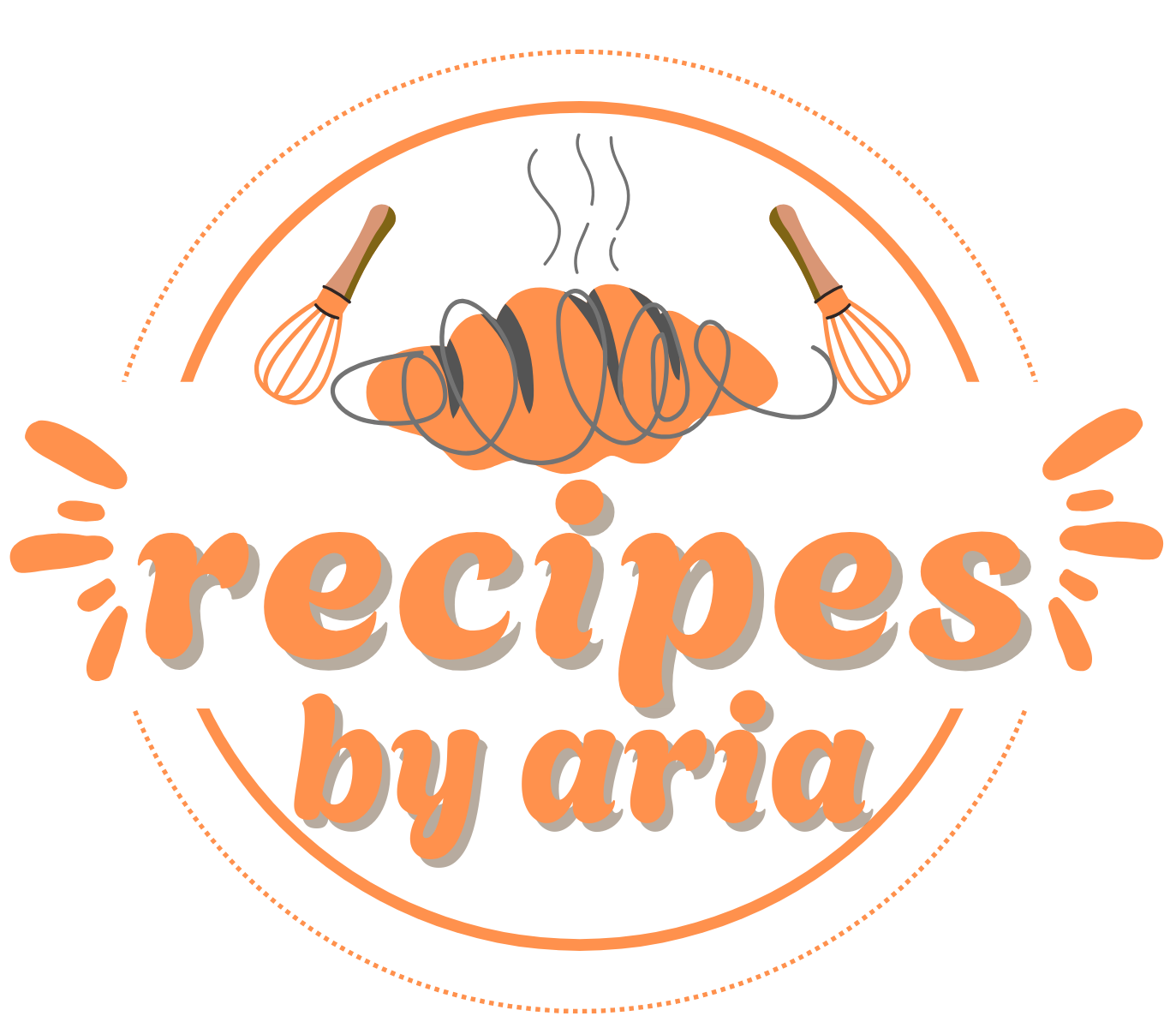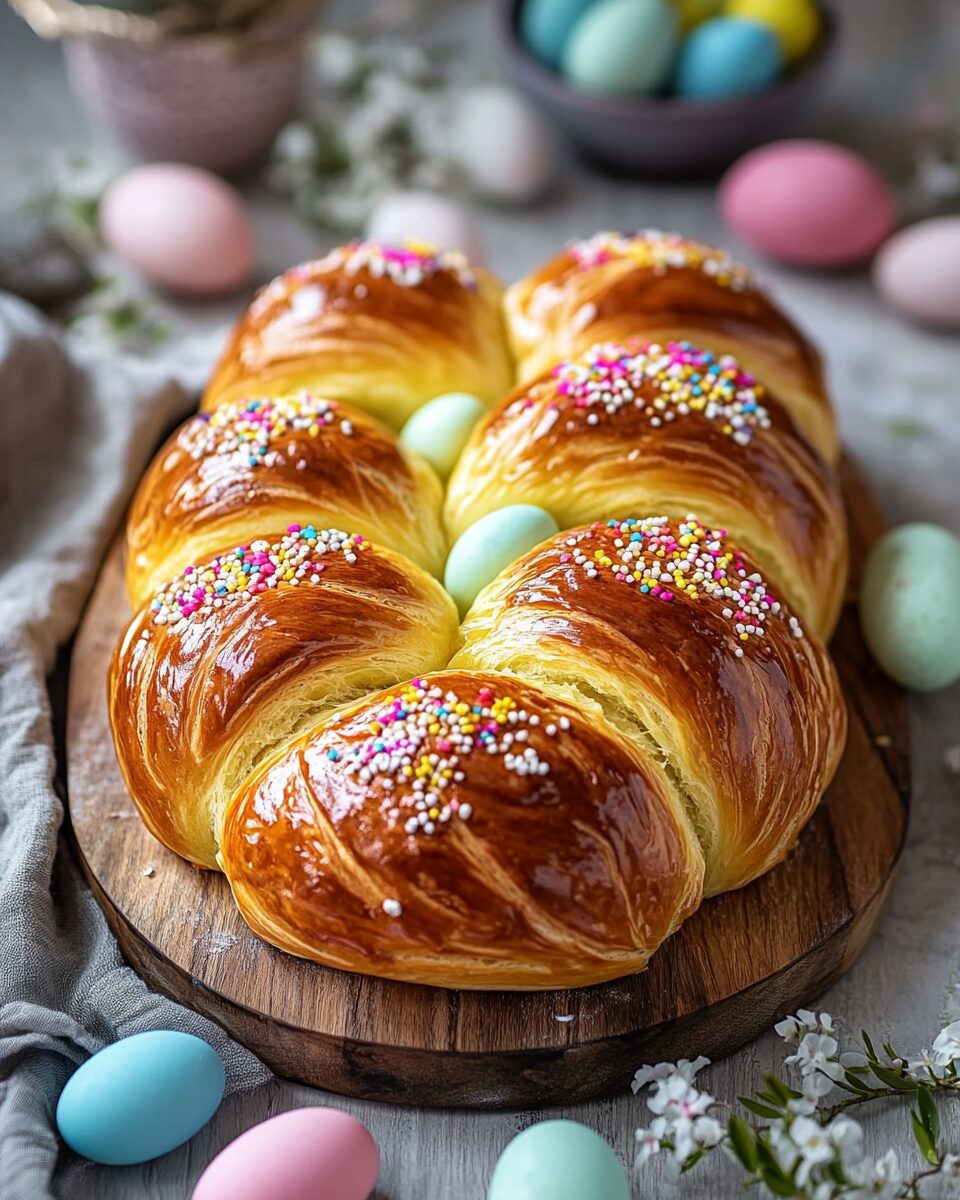This Traditional Italian Easter Bread is a perfect centerpiece for any holiday table, with its beautiful golden brown wreath shape and delicate sweetness. Topped with colorful sprinkles, it is both visually stunning and irresistibly delicious.
Ideal for celebrating Easter, this bread’s light and fluffy texture, combined with the bright citrus zest, offers a refreshing yet comforting flavor. Whether enjoyed on its own or paired with a cup of coffee or tea, this bread will bring joy to any occasion. You can easily make it a part of your family traditions, passing it down from generation to generation.
Full Recipe:
Ingredients:
-
1 cup warm water (110°F)
-
2 teaspoons active dry yeast
-
1/4 cup granulated sugar
-
1/4 cup vegetable oil
-
1/2 teaspoon salt
-
4 cups all purpose flour, divided
-
2 large eggs
-
1 tablespoon orange zest
-
1 tablespoon lemon zest
-
1 teaspoon vanilla extract
-
1/2 cup milk
-
1 egg yolk (for brushing)
-
2 tablespoons colored sprinkles (optional)
Directions:
-
In a large bowl, combine warm water, yeast, and a pinch of sugar. Let sit for 5-10 minutes until the yeast becomes foamy.
-
Add the sugar, oil, salt, eggs, orange zest, lemon zest, and vanilla extract to the yeast mixture. Stir to combine.
-
Gradually add 3 cups of flour, one cup at a time, mixing until the dough starts to come together.
-
Pour in the milk and continue adding flour until the dough is soft but not sticky (about 4 cups total).
-
Turn the dough out onto a floured surface and knead for 8-10 minutes until smooth and elastic.
-
Place the dough in a greased bowl, cover with a cloth, and let rise for 1-2 hours, or until doubled in size.
-
Once the dough has risen, punch it down and divide it into two equal parts.
-
Roll each part into a long rope and twist the ropes into a circle, joining the ends together to form two wreaths.
-
Place the wreaths on a greased baking sheet, cover with a cloth, and let rise for another 30 minutes.
-
Preheat the oven to 350°F (175°C). Brush the wreaths with egg yolk and sprinkle with colored sprinkles, if desired.
-
Bake for 25-30 minutes, or until golden brown.
-
Let cool on a wire rack before slicing and serving.
Prep Time: 20 minutes | Cooking Time: 30 minutes | Total Time: 2 hours 50 minutes
Kcal: 250 kcal | Servings: 12 servings
Traditional Italian Easter Bread: A Delicious Slice of Italian Tradition
Italian cuisine is famous for its variety, rich flavors, and, most importantly, its deep connection to tradition. One such iconic dish that beautifully blends flavor and heritage is Traditional Italian Easter Bread. This sweet, soft, and aromatic bread is a symbol of renewal, new beginnings, and the arrival of spring, making it the perfect centerpiece for Easter celebrations. Its origins lie in Southern Italy, where this recipe has been passed down through generations, symbolizing the joy and unity of family and faith.
As the name suggests, this bread is traditionally prepared for Easter, with the circular shape often representing the eternal love and sacrifice of Christ, as well as the promise of renewal. Over the years, it has evolved into a beloved seasonal treat that brings families together to celebrate Easter Sunday. The inclusion of bright citrus zest, a hint of vanilla, and the golden crust create a rich, festive treat that’s perfect for brunches, picnics, or as a sweet gift for loved ones.
The Significance of Easter Bread in Italian Culture
For Italians, Easter is a time to celebrate with food. The festive bread holds deep religious and cultural significance, and its preparation is a cherished family activity. Whether enjoyed in a small village or at a large family gathering, this bread helps commemorate the religious traditions and cultural customs associated with Easter.
The circular shape of the bread is often linked to the resurrection of Christ. In some regions, it is even adorned with dyed eggs placed in the center of the bread, symbolizing the new life that Easter brings. The rich, sweet dough, which is slightly enriched with butter or oil, creates a light and airy texture. The sweet, citrusy aroma fills the house, evoking a sense of warmth and community.
Easter bread is often enjoyed in the early morning hours on Easter Sunday, sliced and served with a cup of coffee or tea, while families come together for an intimate breakfast. The bread is not just a food item but a symbol of unity, a celebration of life, and an offering of joy.
The Evolution of Traditional Italian Easter Bread
The recipe for Easter bread varies slightly from region to region in Italy, with subtle differences in ingredients or baking methods. However, the core elements remain the same: the bread is sweet, rich, and aromatic. Southern Italy, especially Sicily, Calabria, and Naples, is where the most traditional recipes originate, and each area has its own unique twist.
In Sicily, for example, it’s not uncommon to add anise seeds or fennel, giving the bread a slightly licorice like flavor that enhances its sweetness. In Naples, eggs are often placed in the center of the wreath, both for decoration and symbolism. The eggs are sometimes painted in bright colors to celebrate spring’s arrival, with the bread serving as a festive centerpiece on the Easter table.
The method of making Easter bread also varies, with some families opting for a more straightforward version, while others add a complex layering of flavors with different types of sugar syrups, fruits, or nuts. No matter the variation, the recipe’s heart lies in its ability to bring people together, making it the perfect food to share at a celebration.
Why This Italian Easter Bread is So Special
What makes this Traditional Italian Easter Bread stand out is its combination of texture, flavor, and cultural significance. The dough is rich yet light, soft yet slightly chewy, making each slice of the bread both comforting and indulgent. The hint of orange and lemon zest, paired with a delicate vanilla note, gives the bread a refreshing, almost floral fragrance that reminds you of spring’s arrival.
This bread is often slightly sweet, but not overwhelmingly so, making it a perfect accompaniment to both savory and sweet dishes. Serve it with soft cheese, cured meats, or enjoy it with a dollop of fruit preserves or honey. It can be sliced and served at any Easter meal, from a casual family brunch to a formal dinner.
The beautiful golden brown crust provides a contrast to the soft, airy interior, creating a perfect balance of textures. And for those who enjoy the aesthetic appeal of food, the colorful sprinkles that top the bread add a festive touch, making it an eye catching centerpiece for any table. It’s a joy not just to eat, but also to look at.
Variations and Personal Touches
While the traditional recipe for Italian Easter Bread is delicious on its own, there’s plenty of room for creativity and personalization. Many families have their own variations of the bread, passed down from generation to generation. For example, some may choose to substitute the traditional eggs for chocolate eggs, making it a sweet twist for kids. Others might infuse the dough with a variety of spices, such as cinnamon or cardamom, for a more aromatic experience.
Some people even add raisins, sultanas, or other dried fruits, which pair wonderfully with the citrus zest and help add an extra layer of sweetness. The use of whole eggs, sometimes dyed to represent the renewal of life, is another tradition many families hold dear. The eggs are often placed in the center of the bread or nestled into the dough as it bakes, turning them a beautiful golden color while adding flavor and richness.
Another variation you can try is adding a drizzle of icing over the top of the bread after it’s cooled. This simple addition can add an extra layer of sweetness, making the bread even more decadent. Some families even use colorful sprinkles, especially in Italy, where sprinkles are often associated with festive foods and celebrations.
Making Traditional Italian Easter Bread at Home
Making Traditional Italian Easter Bread at home might seem like a labor of love, but it’s actually quite simple and enjoyable. The dough requires a bit of patience, but the process is straightforward. Allow the dough to rise and shape it carefully, taking time to form the circular wreath. Once baked, you’ll be rewarded with the softest, fluffiest bread you’ve ever tasted.
For the best results, be sure to use fresh, high-quality ingredients. The yeast should be active, and the flour should be soft and finely ground to ensure a smooth, supple dough. Also, don’t rush the rising times; giving the dough enough time to rise will result in a lighter, airier bread. If possible, let the dough rise slowly in a warm place to develop more flavor.
Whether you’re a beginner baker or a seasoned pro, the process of making Easter bread will bring a sense of accomplishment and connection to Italian tradition. Plus, the result is something so special that it’s worth every minute of effort.
Why You Should Make This Italian Easter Bread
Italian Easter Bread is more than just a recipe; it’s a connection to culture, history, and family. It brings people together in the kitchen and at the table, fostering a sense of community and celebration. The soft, sweet bread is versatile and delicious, perfect for serving as a snack, breakfast, or even as a gift.
It’s also a great way to introduce others to Italian traditions and culture. Whether you’re hosting a large Easter gathering or simply looking to share a piece of Italy with your friends and family, this bread is sure to be a crowd pleaser. And as with many traditional recipes, the true magic happens when you make it with love and share it with those you care about.
Conclusion:
In conclusion, Traditional Italian Easter Bread is not just a delicious treat but a meaningful part of Italian heritage. It brings people together in celebration, offering both comfort and joy. The recipe may have originated centuries ago, but its significance and the joy it brings to the table remain timeless. Whether you’re new to making this bread or continuing a family tradition, it’s a recipe worth sharing and cherishing.
The soft, fragrant bread, adorned with colorful sprinkles or even a decorated egg, serves as a beautiful reminder of Easter’s message of hope, renewal, and new beginnings. It’s a simple but profound way to celebrate with loved ones, making memories and savoring every bite of this sweet Italian treat.






